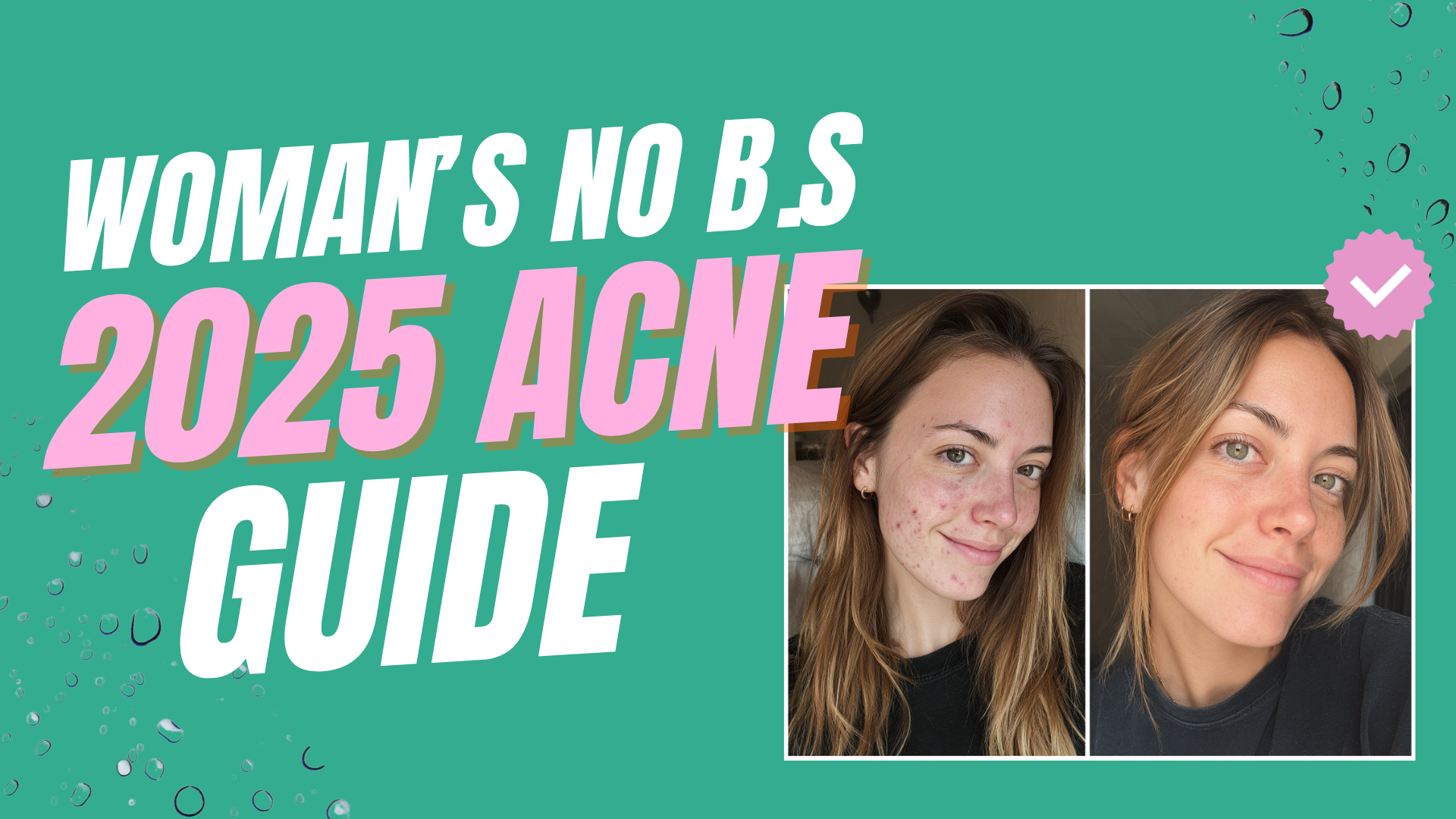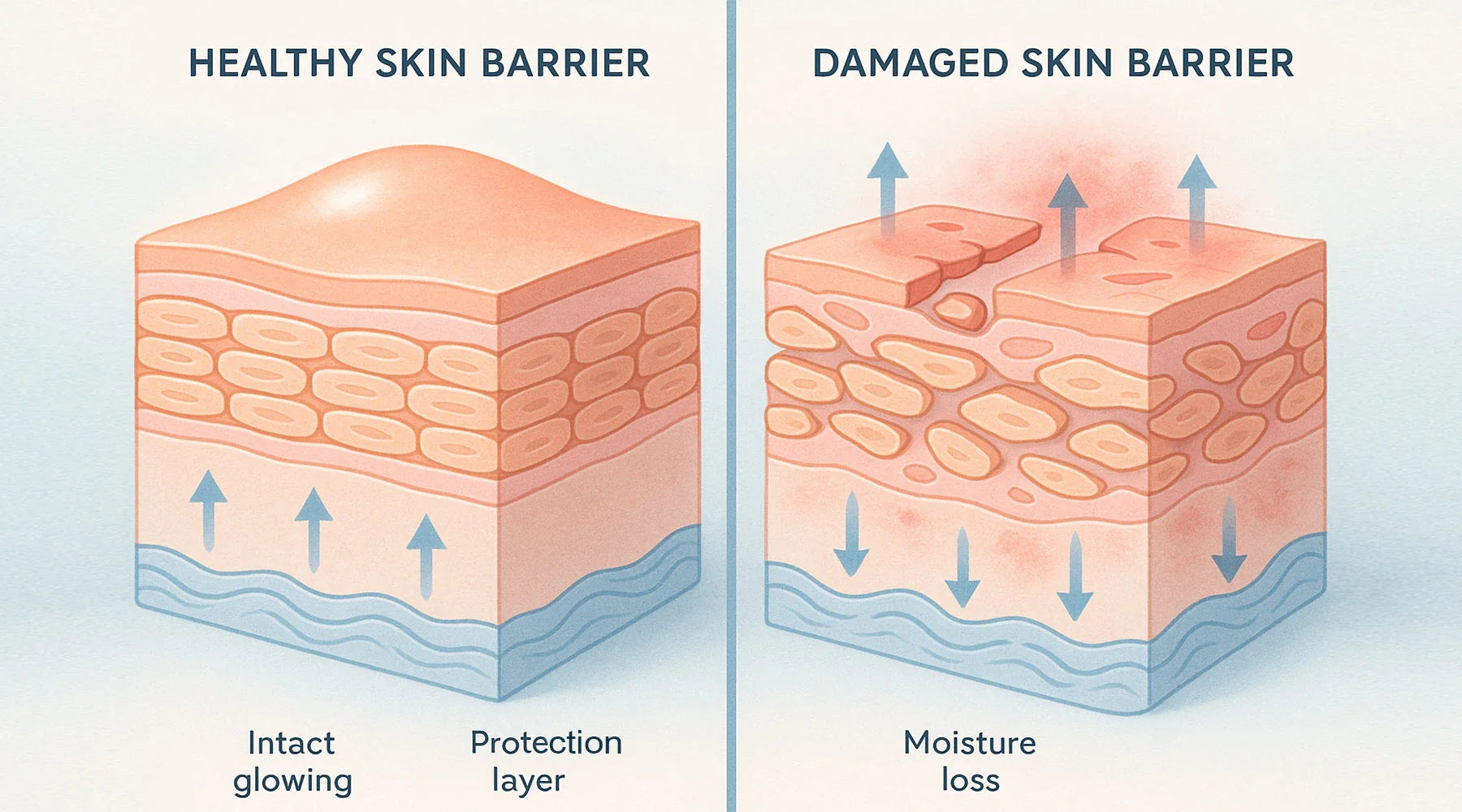Acne Burns on Face? Your Products Are Probably Working Against You
You’ve been doing everything right. A consistent routine. Double-cleansing after long days. Following instructions, avoiding the urge to pop, and keeping up with what dermatologists and beauty blogs say. And yet, you’re still dealing with acne burns on face.
The sting, the redness, the peeling. It’s enough to make you wonder if the cure’s worse than the breakout.
This isn’t your fault. Many acne treatments, even the ones marketed as safe, can actually trigger irritation, inflammation, or even chemical burns when used on already-compromised, hormonal, or sensitive skin.
In this post, we’ll walk through:
- Why your acne products might be working against you
- What ingredients commonly cause burns or irritation
- How to tell the difference between a tingle and damage to your skin condition.
- What to do if you think you’ve experienced a burn caused by acne treatments
- How to heal, reset, and find options that work with your skin, not against it
- Let’s start by unpacking why so many acne treatments hurt more than they help.
Why Acne Treatments Might Burn Your Skin

Ever followed the steps, applied a new treatment, and felt the sting set in? You’re not alone, and you’re not overreacting. That flush, itch, or burn isn’t your skin “adapting.” It might be the first sign of an acne burn on your face.
If an acne product makes your face burn, does that mean it’s working?
Let’s shut down this myth. Burning doesn’t mean it’s working. It means your skin is on defense.
The idea that pain equals progress? Outdated. If you’re dealing with adult acne and hormonal shifts, your skin is already in a reactive state. The last thing it needs is a harsh formula, throwing it further off balance.
A gentle tingle from exfoliating acids? Expected.
But intense stinging, itching, flaking, or redness? That’s not clarity on the way, it’s inflammation in progress. And inflammation means damage, not detox.
Tingling vs. Burning: Know the Difference
- Tingling - mild and temporary, often from well-tolerated actives
- Burning/irritation - Skin irritation lingers, escalates, and shows up as redness, peeling, or discomfort.
Irritation or Allergy? How to Tell
Even well-informed routines can backfire. Here’s how to spot the difference between skin irritation and a normal reaction:
- Irritation builds up with repeated use, especially on already-stressed skin
- Allergic reactions are sudden and dramatic (think hives or swelling)
Why Adult Skin Reacts Differently
Between shifting hormones, career stress, and life changes, your skin condition isn’t the same as it was a decade ago. Adapt your skincare routine accordingly. That means your skincare shouldn’t be either.
Adult acne, specifically, adult female acne, is distinct from teenage acne, often demanding a personalized, long-term care strategy. Adult, hormonal skin is more prone to inflammation, especially when overloaded with harsh ingredients, drying alcohols, or too many active steps. What worked with you when you were 21 might now lead to an acne burn overnight.
Common Culprits: Ingredients That May Cause a Burn Caused by Acne Treatments

You might be surprised to learn that many popular acne-fighting ingredients can trigger an acne burn, especially when overused, misapplied, or layered incorrectly. Let’s look at the usual suspects behind that painful acne burning sensation and how they affect sensitive, stressed, or hormonal skin.
Salicylic Acid: Hero or Hazard?
This beta hydroxy acid (BHA) is a go-to for unclogging pores and cutting through oil. And yes, it works. But it’s not always gentle.
- Why it helps: Deep-cleans pores, exfoliates, and reduces inflammation
- Why it hurts: Overuse can strip your skin barrier, leading to dryness, peeling, and yep, burns on face
Benzoyl Peroxide: Bacteria Killer or Barrier Breaker?
Known for wiping out acne-causing bacteria fast but not without collateral damage.
- Why it helps: Powerful antibacterial action
- Why it burns: It’s an oxidizer that can inflame and dry out even resilient skin—especially when layered with other actives
Retinoids: High Reward, High Risk
These vitamin A derivatives speed up cell turnover and smooth texture but come with a learning curve your skin won’t let you ignore.
- Why it helps: Clears pores, fades dark spots, refines skin
- Why it burns: The infamous “retinization” phase = peeling, redness, and burning
Azelaic Acid: The Understated Ally
Less flashy, but often more forgiving. Azelaic acid fights bacteria and fades pigmentation, making it ideal for sensitive or reactive skin types.
- Why it helps: Targets breakouts and discoloration
- Why it may still irritate: Higher concentrations can tingle or cause mild discomfort
Topical Antibiotics: Not Always Innocent
Think clindamycin and friends. These can calm inflammation but often come mixed with drying alcohols or combined with aggressive routines.
- Why it helps: Tackles cystic or infected acne
- Why it burns: Combined with harsh ingredients, they can wreck your skin’s protective barrier
Healing a Chemical Burn From Acne Treatments

If your face feels raw, red, or reactive after using skincare products, you're not just “being sensitive”; you might be dealing with a chemical burn from acne treatments. It’s more common than you think, and it’s not your fault.
The fix? Stop the harsh stuff, and start focusing on repair.
Spot the Burn Before It Worsens
Catching it early can save your skin from long-term damage. Here’s what to look out for:
- A burning sensation that sticks around even after rinsing
- Peeling, flaking, or tightness that your usual moisturizer can’t calm
- Itching or redness that gets worse with continued product use may indicate damaged skin; consider stopping the use of that product.
- Sudden sensitivity to sunscreen, water, or even your gentle cleanser
Aloe Vera: Not Trendy. Just Tried and True.
Aloe isn’t flashy, but when your skin’s in meltdown mode, it can be a soothing addition to your skincare routine. It’s gold.
- Why it works: Packed with polysaccharides that hydrate and help trigger your skin’s healing process
- How to use it: Stick to pure, fragrance-free aloe vera gel—apply to clean, dry skin 2–3 times daily
Heads-up: Aloe won’t fight acne alone; consider incorporating glycolic acid into your skincare routine. But it will help calm acne burns on the face and speed recovery between treatment phases.
What to Use (Once You’re Past the Sting)
Once the burn cools down, bring in ingredients that help your skin rebuild, not just “fight acne.”
- Niacinamide: Calms redness, strengthens skin
- Allantoin is a beneficial active ingredient that can help soothe damaged skin in your skincare products.: Soothes and promotes recovery
- Squalane & Hyaluronic Acid: Hydrate deeply without clogging pores
- Ceramides: Rebuild and reinforce your skin barrier
This is where Dual-Clear Mist shines. It's gentle, barrier-friendly, and formulated to treat acne without the burn. Use it during recovery or as a long-term swap for harsher routines.
When It’s Time to Call Your Dermatologist
See a professional if you notice:
- Blisters, open wounds, or oozing can indicate a serious skin condition that requires immediate attention in your skincare routine.
- Ongoing swelling or pain
- Zero improvement after several days of gentle recovery
Your dermatologist can rule out allergies, infections, or deeper damage and help you get back on track with a skincare routine that includes effective active ingredients that work with your skin, not against it.
Alternative Acne Treatments for Sensitive Skin
If you’ve dealt with an acne burn or that lingering sting that won’t quit, you might be wondering: Is this really the way to clear skin?

Good instinct. Because here’s the truth: effective acne care shouldn’t hurt. In fact, long-term results often come from consistency, not intensity.
Are There Gentler, More Effective Options?
Yes. And they’re not just gentler, they’re smarter, backed by dermatology and biotech, and built to work with your skin, not against it.
Look for:
- Bi-phase mists that balance oil and calm inflammation
- Barrier-friendly treatments with niacinamide, calendula, green tea
- Minimalist routines that don’t overload or overwhelm
Dual-Clear Acne Treatment Mist is a science-first, 99.54% natural origin formula designed to fight breakouts without the backlash. Dermatologist-tested, hormone-skin-friendly, and stinging-free.
- One spray = oil control + skin-calming action
- For face, chest, and back
- No peeling. No dryness. No burning.
Prevention First: How to Avoid a Burn Caused by Acne Treatments

Once you’ve been burned — literally — you don’t look at an ingredient list the same way again. And honestly? You shouldn’t have to. Prevention is less painful, more empowering, and way more effective than trying to undo the damage.
Here’s how to stop acne burns before they start.
Start slow and stay smart. (Yes, Even With “Clean” Products)
Patch testing isn’t just for sensitive skin, it’s for smart skin. If your barrier’s been compromised before, treat new products like a first date.
- Dab a small amount behind your ear or on your jaw
- Wait 24–48 hours
- If all’s good, start slow, every other day, max
This one move could save you from another full-face meltdown!
Watch for Ingredient Overload
It’s easy to accidentally layer salicylic acid in your cleanser, benzoyl peroxide in your toner, and retinoids in your night cream. Even if each product looks “gentle,” your skin adds it all up.
Simplify. Pick one active. Stick with it. Build from there only if your skin agrees or with guidance from a pro.
Ask Your Dermatologist Smarter Questions
If you’ve had an acne burn or a chemical burn on face, your skincare plan needs more than guesswork. Bring your dermatologist into the conversation with targeted questions like:
- Are there lower-strength or buffered options I can try in my skin care products to minimize irritation?
- What hydrators won’t clog my pores but will support my barrier?
- How do I time treatments around hormonal flare-ups?
Choose Treatments That Actually Care
You shouldn’t have to pick between clear skin and healthy skin. And with the right formula, you don’t have to.
Dual-Clear Acne Treatment Mist is built for prevention as much as it is for treatment.
Final Thoughts: Clear Skin Shouldn’t Burn
If you’re dealing with acne burns on your face, it’s not your fault, and it’s not a sign your products are working. That burning sensation is your skin telling you it’s had enough. You don’t need to stop treating acne; just adjust your skincare routine to better suit your current skin condition.
Dual-Clear was made with that balance in mind. No stinging, no stripping, just real care for real skin.




Leave a comment
This site is protected by hCaptcha and the hCaptcha Privacy Policy and Terms of Service apply.